While I’m on holiday this week, restoring and re-setting, I’ve been sharing pages from my ABCovid-19 Journal with readers of Health Populi. I created this journal during the early phase of the pandemic in the U.S., as a form of art therapy, creative outlet, and learning.
Today is Day 4 of sharing: we consider the letters “P” through “T,” and what I saw in the early coronavirus era.
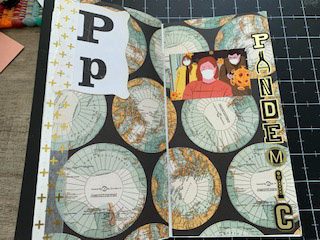 P is for pandemic
P is for pandemic
This “P” was self-evidence in our collective early COVID-19 lexicon. The “P” word was uttered by the Secretary General of the World Health Organization on March 11, confirming that the coronavirus was, technically, a pandemic.
I started this journal page with paper illustrating different views of the globe in mini Mercator maps. On the left-hand page, I used trim of Washi tape of gold crosses, which could represent several symbols of the moment: death, health care, faith among them.
I spelled out the word “pandemic” using a mixed alphabet reminiscent of steampunk. The letters in this set are also un-matched, evoking a feeling of chaos and lack of control, even a kidnapping note.
The photo is an illustration I cut out of a magazine of people wearing m asks from different walks of life and demographics. They are alone, together, with a symbol of the coronavirus at the right.
The general theme here is that the pandemic is a global phenomenon, and that we humans are very small actors in a very big public health crisis.
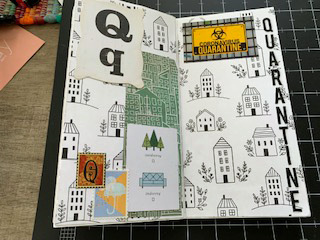 Q is for quarantine
Q is for quarantine
There aren’t many “Q” words, but “quarantine” was obviously, well, obvious for the ABCovid-19 vocabulary from the start of the pandemic.
This page started with base paper of individual houses, unconnected, in white space. They are drawn like a child’s school art page, which I felt appropriate given how naive and uninformed we felt at the start of the Great Lockdown and mandate to shelter-in-place, in our own homes.
I added in an Insta-sized photo of a warning: “Coronavirus Quarantine” in the alarming gold and black colors we expect from signs telling us to pay careful attention.
A journaling card at the bottom added an ironic touch, which features trees and a sofa. The contrast in the quarantine time is that trees are “outside” and sofas, “in.” We were all compelled to stay “in,” longing for nature at the moment.
A faux postage stamp of an umbrella adds another graphic touch: umbrellas are often used as an icon in insurance campaigns to signify we are protected from external elements that can injure us in some way. An “umbrella” was also called into play by the FDA, which streamlined clinical trial protocols to expand the possible candidates for coronavirus treatments.
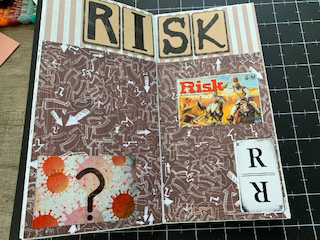 R is for risk
R is for risk
Among the many “R” words we could conjure up in the early COVID-19 era, “risk” to me was top-of-mind. Every one of us was physically distancing to manage our risk to the virus from the beginning. It became a top job or life-flow to manage our risks, pushing us down to the physiological and safety rungs of Maslow’s hierarchical basic needs ladder.
I laid the brown arrow-crowded paper on the base of this page, pointing in every direction. How to manage risk without complete information on the coronavirus? We didn’t have a map for this challenge.
The big question mark at the bottom left, designed atop artfully drawn coronavirus graphics, came out of a magazine story.
I printed out a copy of the vintage board game box for Risk, one of my husband’s favorites from his childhood. Interestingly, playing board games gained favor during the pandemic, as more people were staying home with loved ones and friends looking for past times off-the-grid and away from digital platforms. So board games and Old School jigsaw puzzles gained sales in the second quarter of 2020.
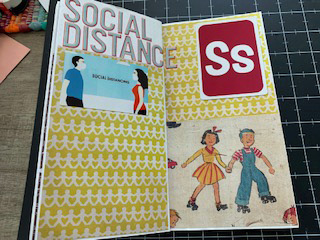 S is for social distancing
S is for social distancing
One of the earliest recommendations from the White House Coronavirus Task Force leaders Dr. Birx, Dr. Fauci, and Dr. Adams was for health citizens to “socially distance:” that is, stay the heck away from each other to avoid exposure to the coronavirus.
What this ultimately meant was to stay away from other people, to self-isolate. This would lead to an epidemic inside the pandemic: the erosion of our mental health.
For this journal page, I started with a sweet, naive yellow base of mini paper dolls holding hands, hundreds of them across the two pages. Then, I cut out a little girl and boy holding hands from a vintage scrapbook piece of paper I was saving for my own childhood book/biography but thought it would be well-utilized here.
I found the drawn picture of a man and woman, masked, proverbially six-feet apart, which I pasted catty-corner from the kids.
This “S” has been one of the most toxic side-effects of the pandemic for each of us, in every country impacted by the coronavirus.
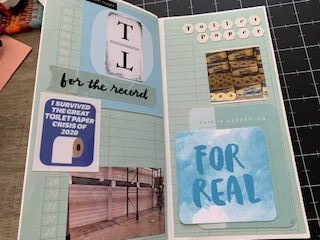 T is for toilet paper
T is for toilet paper
For some comic-relief, I had to use toilet paper for the “T” page. In Asia and Europe, retail data analysts recognized early hoarding behavior among consumers, concerned about grocery store supply chains for essential goods like hand sanitizer, paper towels and, indeed, bathroom tissue.
I shot the photo at the lower left while shopping at a Big Box store, shelves emptied of Charmin, Northern, and other toilet rolls we’re so accustomed to seeing stacked high on pallets at retail. The photo in the upper right is also from my own shopping, happily finding Wegmans private label bathroom tissue on one of my visits to the grocer in the pandemic. As with many items challenged in the supply chain, the limit per shopper was “one.”
The sticker reading, “I survived the great toilet paper crisis of 2020” came from one of the crafting subscription boxes I regularly receive: it’s been amazing to see how these companies created pandemic-themed crafting supplies in the pandemic.
The “For Real” journaling card came from a series I’ve used in my other journals I use in ongoing everyday journals.
Now you know your “Ps” through “Ts.” Tomorrow, we concluded the ABCovid-19 journal, with “U” through “Z.” You’ll encounter unemployment, virus, Wuhan, Disease “X,” yeast, and Zoom.
Thank you for checking in, and please stay well and artful in your own pandemic journey.




 Interviewed live on BNN Bloomberg (Canada) on the market for GLP-1 drugs for weight loss and their impact on both the health care system and consumer goods and services -- notably, food, nutrition, retail health, gyms, and other sectors.
Interviewed live on BNN Bloomberg (Canada) on the market for GLP-1 drugs for weight loss and their impact on both the health care system and consumer goods and services -- notably, food, nutrition, retail health, gyms, and other sectors. Thank you, Feedspot, for
Thank you, Feedspot, for  As you may know, I have been splitting work- and living-time between the U.S. and the E.U., most recently living in and working from Brussels. In the month of September 2024, I'll be splitting time between London and other parts of the U.K., and Italy where I'll be working with clients on consumer health, self-care and home care focused on food-as-medicine, digital health, business and scenario planning for the future...
As you may know, I have been splitting work- and living-time between the U.S. and the E.U., most recently living in and working from Brussels. In the month of September 2024, I'll be splitting time between London and other parts of the U.K., and Italy where I'll be working with clients on consumer health, self-care and home care focused on food-as-medicine, digital health, business and scenario planning for the future...